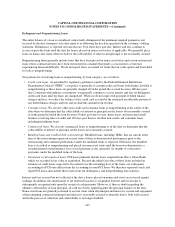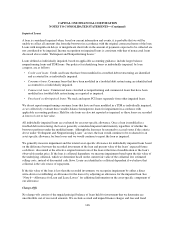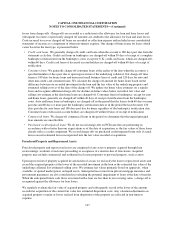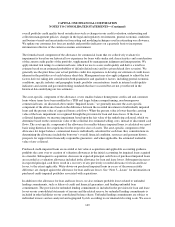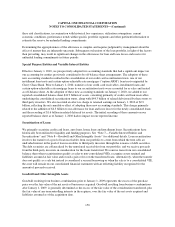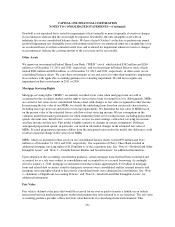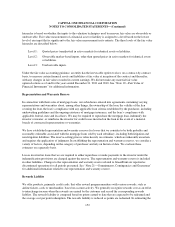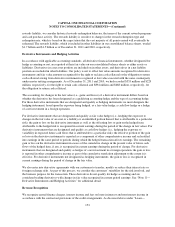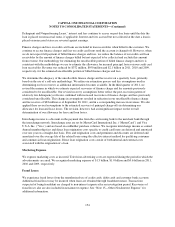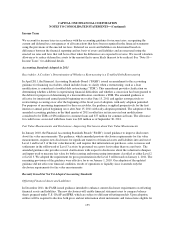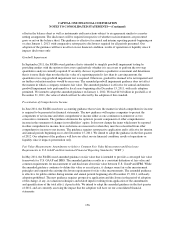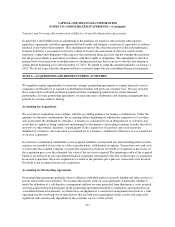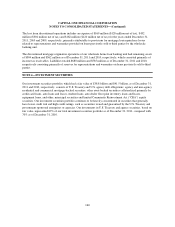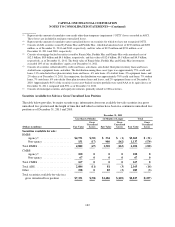Capital One 2011 Annual Report Download - page 173
Download and view the complete annual report
Please find page 173 of the 2011 Capital One annual report below. You can navigate through the pages in the report by either clicking on the pages listed below, or by using the keyword search tool below to find specific information within the annual report.CAPITAL ONE FINANCIAL CORPORATION
NOTES TO CONSOLIDATED STATEMENTS—(Continued)
rewards liability, we consider historical rewards redemption behavior, the terms of the current rewards programs
and card purchase activity. The rewards liability is sensitive to changes in the reward redemption type and
redemption rate, which is based on the expectation that the vast majority of all points earned will eventually be
redeemed. The rewards liability, which is included in other liabilities in our consolidated balance sheets, totaled
$1.7 billion and $1.5 billion as of December 31, 2011 and 2010, respectively.
Derivative Instruments and Hedging Activities
In accordance with applicable accounting standards, all derivative financial instruments, whether designated for
hedge accounting or not, are reported at their fair value on our consolidated balance sheets as either assets or
liabilities. Derivatives in a net asset position are included on in other assets, and derivatives in a net liability
position are included in other liabilities. Our policy is not to offset fair value amounts recognized for derivative
instruments and fair value amounts recognized for the right to reclaim cash collateral or the obligation to return
cash collateral arising from derivative instruments recognized at fair value executed with the same counterparty
under master netting arrangements. As of December 31, 2011 and 2010, we had recorded $353 million and $229
million, respectively, for the right to retain cash collateral and $894 million and $668 million, respectively, for
the obligation to return cash collateral.
The accounting for changes in the fair value (i.e., gains and losses) of a derivative instrument differs based on
whether the derivative has been designated as a qualifying accounting hedge and the type of accounting hedge.
For those derivative instruments that are designated and qualify as hedging instruments we must designate the
hedging instrument, based upon the exposure being hedged, as a fair value hedge, a cash flow hedge or a hedge
of a net investment in a foreign operation.
For derivative instruments that are designated and qualify as fair value hedges (i.e., hedging the exposure to
changes in the fair value of an asset or a liability or an identified portion thereof that is attributable to a particular
risk), the gain or loss on the derivative instrument as well as the offsetting loss or gain on the hedged item
attributable to the hedged risk is recognized in current earnings during the period of the change in fair values. For
derivative instruments that are designated and qualify as cash flow hedges (i.e., hedging the exposure to
variability in expected future cash flows that is attributable to a particular risk), the effective portion of the gain
or loss on the derivative instrument is reported as a component of other comprehensive income and reclassified
into earnings in the same period or periods during which the hedged transaction affects earnings. The remaining
gain or loss on the derivative instrument in excess of the cumulative change in the present value of future cash
flows of the hedged item, if any, is recognized in current earnings during the period of change. For derivative
instruments that are designated and qualify as hedges of a net investment in a foreign operation, the gain or loss
is reported in other comprehensive income as part of the cumulative translation adjustment to the extent it is
effective. For derivative instruments not designated as hedging instruments, the gain or loss is recognized in
current earnings during the period of change in the fair value.
We also enter into derivative agreements with our customers to transfer, modify or reduce their interest rate or
foreign exchange risks. As part of this process, we consider the customers’ suitability for the risk involved, and
the business purpose for the transaction. These derivatives do not qualify for hedge accounting and are
considered trading derivatives with changes in fair value recognized in current period earnings. See “Note 11—
Derivative Instruments and Hedging Activities” for additional detail.
Revenue Recognition
We recognize earned finance charges, interest income and fees on loans in interest and non-interest income in
accordance with the contractual provisions of the credit arrangements. As discussed above under “Loans—
153




